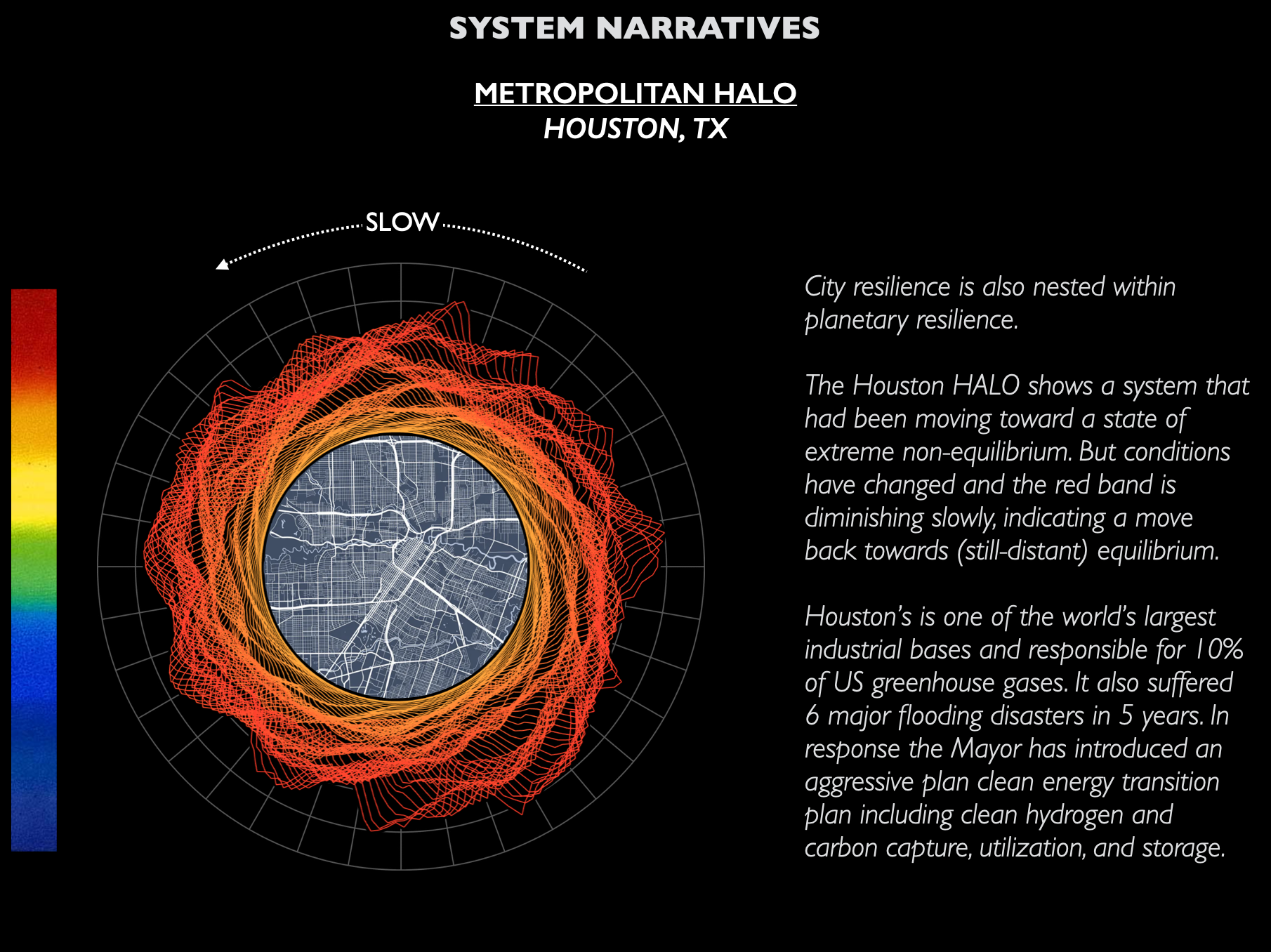You do not rise to the level of your goals.
You fall to the level of your systems.
James Clear
Summary
Urban resilience is a critical concern in the face of climate change, yet citizen engagement remains disappointingly low.
There are a lot of theories why, but from a behavioral science perspective at least one answer is straightforward: cities have failed to deploy actionable feedback signals that connect people to the progress—or lack thereof—of resilience initiatives.
This paper introduces the HALO System as a driver for climate engagement. By visualizing real-time effects of actions taken toward city resilience goals, this system fosters a proactive community involved in tangible, collaborative and competitive scenarios that enhance urban environments, while providing urban climate leaders with a direct communications channel to citizens.
The Challenge
Urban residents are often unaware of the direct impact their actions (and inactions) can have on their city’s state of resilience. Conventional communication methods have not sufficed to mobilize collective action towards sustainability goals, leading to low engagement and minimal perceptible impact.
Moreover, and more fundamentally, climate data is often presented in complex and categorical static frameworks that fail to present holistic pictures of a city’s resilience status. So individual actions appear meaningless.
A Solution: HALOs for Cities
The HALO System for Cities introduces an intuitive and engaging live feedback interface for urban resilience. By adopting HALO signaling technology, cities can dynamically illustrate the impact of individual and collective actions on resilience goals. Deployed as a city-wide game—and an inter-city competition between neighborhoods and corporates—HALOs become real-time markers of engagement and momentum, directly reflecting responses to resilience directives.
HALOs are holistic and scalar. They synthesize multi-contextual data flows into a singular, intuitive, multi-dimensional object that conveys the city’s overall state of resilience, and how individuals and organizations at each ‘level’ contribute to that score. This holistic view fosters clarity and motivates collective action by highlighting the cumulative impact of all efforts, ensuring no single metric dominates attention at the expense of the whole system.
These slides introduce the HALO and how data flows into the object to signal the moment-to-moment status of an entity:
HALOs are most effective when integrated into dashboards alongside categorical KPIs (Key Performance Indicators). In a city HALO dashboard, metrics like energy usage, composting rates, commuter choice statistics, and water capture would each have their own individual meters. These metrics are essential for tracking and rewarding specific performance indicators and informing targeted interventions. However, without a unifying signal, the narrative of progress remains fragmented, making it difficult for people to connect their actions to broader resilience goals. The HALO resolves this by synthesizing data into a singular, intuitive signal that conveys the city’s overall state of resilience.
Here are a sequence of slides that explain how the HALO system operates, and how it can be applied to signaling the resilience status of a city.
Here is a breakdown of how the HALO can be configured to signal climate resilience:
Now that you have a basic understanding of the HALO, here is how it can be deployed as a game for city’s to unify citizens around critical resilience objectives:
Game Mechanics:
Centralized City Resilience HALO:
Acts as the game’s scoreboard, dynamically reflecting the city's resilience through colors, intensity, and movement based on real-time data and citizen actions.
Updated in real time to show the immediate effects of player actions, encouraging continuous engagement.
Individual and Neighborhood HALOs:
Players (citizens) have personal HALOs that track their contributions to city resilience.
Neighborhoods and corporates can compete against each other, with each area displaying its collective HALO score, fostering a sense of community and rivalry.
Scalar HALOs level-up to represent neighborhood, organizational, and city status (in a nationwide game) based on verified climate-actions.
Intelligent Directive System:
The HALO not only visualizes data but also suggests actionable steps for improvement based on real-time conditions.
Functions as a recommendation engine, providing scalable solutions from recycling initiatives to policy participation.
Missions and Rewards:
Players complete sustainability-related tasks (e.g., reducing energy consumption, checking in on public transport) to improve their personal, neighborhood, and corporate HALOs.
Achievements unlock rewards such as city credits, discounts on services, or real cash incentives.
Precision Messaging and Neighborhood HALOs:
Once deployed, the HALO system acts as a precision messaging tool, facilitating targeted communication between city officials and citizens based on neighborhood and activity metrics.
Neighborhoods can have their own HALOs, displaying collective actions and regional uptake of resilience measures, further incentivizing community participation through visible progress and rewards.
The state of the CITY HALO influences individual, household, neighborhood, and institutional (corporate and organizational) behaviors, which in turn affect the CITY HALO. This feedback loop can drive changes in behavior and policy, aiming for a more sustainable and resilient planet.
Implementation Strategy:
Integration of Data: Leverages environmental, infrastructural, and social data to fuel the game mechanics, ensuring that each player's actions are accurately reflected in the resilience scores.
Community and Competition: Builds community through local leaderboards, neighborhood teams, and city-wide challenges that make resilience efforts visible and competitive.
Example Application - Houston:
Houston residents could participate in seasonal challenges to lower their carbon footprint. Success would brighten their personal and neighborhood HALOs, contributing to the city’s overall resilience.
Neighborhoods could compete in annual "Greenest Neighborhood" contests, with winners receiving grants for community projects or reductions in municipal fees.
Conclusion: The City Resilience game harnesses the HALO System to transform how citizens interact with urban resilience initiatives. By gamifying the process of improving city resilience, this approach promises to significantly boost public engagement, making sustainability both a personal and collective achievement. Through competition, rewards, and real-time feedback, urban residents are not just informed but are actively involved in shaping their city’s future, turning every individual into a key player in the game of urban sustainability.
Watch a primer on how generative design processes live data into intuitive and actionable objects.













